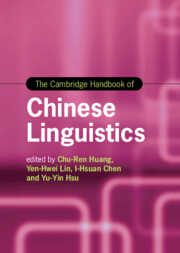Book contents
- The Cambridge Handbook of Chinese Linguistics
- Cambridge Handbooks In Language and Linguistics
- The Cambridge Handbook of Chinese Linguistics
- Copyright page
- Contents
- Figures
- Tables
- Contributors
- Acknowledgments
- Part One Writing System/Neuro-cognitive Processing of Chinese
- Part Two Morpho-lexical Issues in Chinese
- 3 Wordhood and Disyllabicity in Chinese
- 4 Characters as Basic Lexical Units and Monosyllabicity in Chinese
- 5 Parts of Speech in Chinese and How to Identify Them
- 6 Gaps in Parts of Speech in Chinese and Why?
- 7 Derivational and Inflectional Affixes in Chinese and Their Morphosyntactic Properties
- 8 The Extreme Poverty of Affixation in Chinese
- 9 On an Integral Theory of Word Formation in Chinese and Beyond
- 10 Compounding Is Semantics-driven in Chinese
- Part Three Phonetic-phonological Issues in Chinese
- Part Four Syntax-semantics, Pragmatics, and Discourse Issues
- Index
- References
3 - Wordhood and Disyllabicity in Chinese
from Part Two - Morpho-lexical Issues in Chinese
Published online by Cambridge University Press: 04 August 2022
- The Cambridge Handbook of Chinese Linguistics
- Cambridge Handbooks In Language and Linguistics
- The Cambridge Handbook of Chinese Linguistics
- Copyright page
- Contents
- Figures
- Tables
- Contributors
- Acknowledgments
- Part One Writing System/Neuro-cognitive Processing of Chinese
- Part Two Morpho-lexical Issues in Chinese
- 3 Wordhood and Disyllabicity in Chinese
- 4 Characters as Basic Lexical Units and Monosyllabicity in Chinese
- 5 Parts of Speech in Chinese and How to Identify Them
- 6 Gaps in Parts of Speech in Chinese and Why?
- 7 Derivational and Inflectional Affixes in Chinese and Their Morphosyntactic Properties
- 8 The Extreme Poverty of Affixation in Chinese
- 9 On an Integral Theory of Word Formation in Chinese and Beyond
- 10 Compounding Is Semantics-driven in Chinese
- Part Three Phonetic-phonological Issues in Chinese
- Part Four Syntax-semantics, Pragmatics, and Discourse Issues
- Index
- References
Summary
Words pose a theoretical challenge in Chinese, but words pose a challenge in any language. Even though Chinese is written with monosyllabic, monomorphemic characters and no overt word boundaries, there is as much evidence here as there is in English or any other language for a level between the morpheme and the phrase, interfacing between the lexicon and the grammar. Yet their interface role makes words dynamic things, subject to distinct and often conflicting constraints from processing, semantics, phonology, morphology, and syntax. To emphasize the universality of this situation, the chapter starts with a quick look at the dynamic nature of English words before turning to focus on Chinese words, which a wide variety of data reveal as surprisingly English-like, including a strong preference for disyllabicity. The chapter ends by sketching a formalism that may help capture the universal yet dynamic nature of wordhood, showing how it helps account for some of the Chinese facts.
- Type
- Chapter
- Information
- The Cambridge Handbook of Chinese Linguistics , pp. 47 - 73Publisher: Cambridge University PressPrint publication year: 2022
References
- 1
- Cited by

